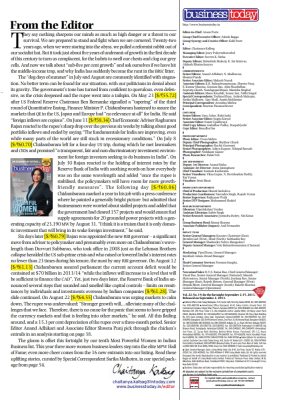10 Most Powerful Women in Indian Business
[Business Today]
Published date: 15th Sep 2013
They say nothing sharpens our minds as much as high danger or a threat to our survival. We are prepared to stand and fight when we are cornered. Twenty-two years ago, when we were staring into the abyss, we pulled a reformist rabbit out of our socialist hat. But it took just about five years of undreamt-of growth in the first decade of this century to turn us complacent, for the hubris to swell our chests and clog our grey cells. And now we talk about “sub-five per cent growth” and ask ourselves if we have hit the middle-income trap, and why India has suddenly become the runt in the BRIC litter.
The “dog days of summer” in July and August are commonly identified with stagnation. No better term can be found for our situation, with our politicians in denial about its gravity. The government’s tone has turned from confident to querulous, even defensive, as the crisis deepened and the rupee went into a tailspin. On May 23 [$/55.72] after US Federal Reserve Chairman Ben Bernanke signalled a “tapering” of the third round of Quantitative Easing, Finance Minister P. Chidambaram hastened to assure the markets that QE in the US. Japan and Europe had “no relevance at all” for India. He said “foreign inflows are copious”. On June 11 [$/58.34] Chief Economic Adviser Raghuram Rajan reacted to the rupee’s sharp drop over the previous six weeks by talking about good portfolio inflows and ended by saying “The fundamentals for India are improving, even while many parts of the world are still stuck in recessionary conditions.” On July 8 [$/60.70] Chidambaram left for a four-day US trip, during which he met lawmakers and CEOs and promised “a transparent, fair and non-discriminatory investment environment for foreign investors seeking to do business in India”. On July 30 Rajan reacted to the holding of interest rates by the Reserve Bank of India with soothing words on how everybody was on the same wavelength and added “once the rupee is stabilised, the policymakers will have room for more growth- friendly measures”. The following day [S/₹60.86] Chidambaram marked a year in his job with a press conference where he painted a generally bright picture but admitted that businessmen were worried about stalled projects and added that the government had cleared 157 projects and would ensure fuel supply agreements for 20 grounded power projects with a generating capacity of 23,190 MW by August 31. “I think it is a truism that it is only domestic investment that will bring in its wake foreign investment,” he said.
Six days later [S/60.79] Rajan was appointed the new RBI governor – a significant move from advisor to policymaker and presumably even more on Chidambaram’s wavelength than Duvvuri Subbarao, who took office in 2008 just as the Lehman Brothers collapse heralded the US sub-prime crisis and who raised or lowered India’s interest rates no fewer than 23 times during his tenure, the most by any RBI governor. On August 12 [$/61.13] Chidambaram assured parliament the current account deficit would be contained at $70 billion in 2013/14 “while the inflows will increase to a level that will be sufficient to finance the CAD”. Yet, just two days later, the Reserve Bank of India announced several steps that sounded and smelled like capital controls – limits on remittances by individuals and investments overseas by Indian companies [$/161.28]. The slide continued. On August 22 [$/164.55] Chidambaram was urging markets to calm down. The rupee was undervalued: “Stronger growth will… alleviate many of the challenges that we face, Therefore, there is no cause for the panic that seems to have gripped the currency markets and that is feeding into other markets,” he said. All this flailing around, and a 15.3 per cent depreciation of the rupee over a three-month period. Senior Editor Anand Adhikari and Associate Editor Shweta Punj pick through the chicken’s entrails in an analysis starting on page 38.
The gloom is offset this fortnight by our tenth Most Powerful Women in Indian Business list. This year three more women business leaders step into the elite MPW Hall of Fame: even more cheer comes from the 16 new entrants into our listing. Read these uplifting stories, curated by Special Correspondent Sarika Malhotra, in our special package from page 54.






